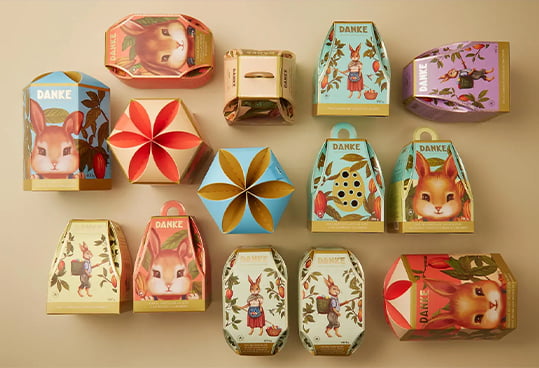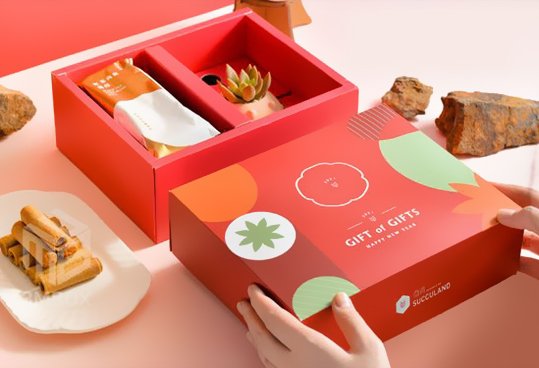
The holiday season is a crucial time for businesses of all sizes, as consumers open their wallets and embark on a shopping frenzy. To stand out in the crowded marketplace and capture a slice of the holiday spending pie, companies must employ clever marketing strategies. One of the most effective ways to do this is through holiday packaging. Well-designed, festive packaging can not only grab the attention of potential customers but also evoke emotions that drive them to make a purchase.
In this blog, we will explore the art and science of holiday box designs to maximize sales. Wait a moment! Let’s first put some light on the significance of designing box packaging for the holiday season.

Holiday Packaging is more than just a decorative box or bag. It is a marketing tool that can boost your sales during the holiday season in several ways:
Attracts Attention: Creative, festive packaging is eye-catching. It can make your product stand out on the shelves or in the sea of online listings, drawing potential customers towards your brand.
Evokes Emotion: Holidays are a time of joy, nostalgia, and giving. Packaging that reflects the holiday spirit can evoke strong emotions in consumers, making them more likely to choose your product as a gift or treat for themselves.
Differentiates Your Brand: Unique Halloween boxes or bags packaging for holidays can set your brand apart from competitors. Customers may choose your product over others simply because of the memorable packaging.
Encourages Impulse Buying: Beautiful packaging can entice shoppers to make impulse purchases. They may decide to buy your product based on its visual appeal alone.
Increases Perceived Value: High-quality, festive packaging can make your product appear more luxurious, increasing its perceived value. Customers are often willing to pay more for products that look and feel special.

To design holiday packaging that maximizes sales, you need to consider several key elements:
Theme and Imagery: Choose a holiday theme that resonates with your target audience. It could be Christmas, Hanukkah, Thanksgiving, New Year, or any other holiday. Incorporate relevant imagery and symbols associated with that holiday, such as snowflakes, Christmas trees, or menorahs.
Color Palette: Select a color palette that aligns with the holiday and your brand. For instance, Christmas Packaging often features red and green, while Hanukkah packaging may use blue and silver. These colors should complement your brand colors to maintain brand consistency.
Typography: Use fonts that match the holiday theme and are easy to read. For example, a script font may convey a sense of elegance during the holidays, while a bold, sans-serif font could evoke a modern and festive look.
Graphics and Illustrations: Incorporate holiday-specific graphics or illustrations that tell a story. These visuals should connect with the holiday and your brand message. Custom illustrations can set your packaging apart from generic designs.
Festive Text: Craft compelling, holiday-themed copy for your packaging. This could be a heartwarming message, a holiday offer, or a call to action. The text should be concise and memorable.
Eco-Friendly Materials: Many consumers appreciate environmentally friendly packaging. Consider using sustainable materials that can be recycled or reused, as this can attract eco-conscious customers.
Practicality: While aesthetics are important, your packaging must also be practical. It should protect the product inside and make it easy for customers to access it. Balancing beauty and functionality is key.
Personalization: Personalized packaging can create a strong connection between your brand and the customer. You can add personal touches like the recipient’s name or a custom message to make your packaging feel more exclusive.

Creating effective packaging involves a structured design process:
Research: Start by researching the holiday you are targeting. Understand the traditions, symbols, and colors associated with it. Study your competitors to see how they approach Holiday Gift Packaging.
Audience Analysis: Identify your target audience. What are their preferences and values during the holiday season? Your packaging should resonate with their emotions and desires.
Concept Development: Brainstorm creative ideas for your packaging. Think about how you can incorporate the holiday theme and imagery into your design. Consider how your packaging can tell a story or convey a message.
Sketch and Mock-Up: Create rough sketches and mock-ups of your packaging design. Experiment with different layouts, colors, and graphics. This is the stage where you can let your creativity run wild.
Feedback and Refinement: Gather feedback from colleagues, friends, and potential customers. Use this feedback to refine your design and make necessary improvements.
Prototype Creation: Develop a physical prototype of your packaging. This allows you to test its functionality and appearance in the real world.
Final Design and Production: Once you’re satisfied with your prototype, finalize the design and prepare it for production. Choose a reliable printing and packaging partner to ensure quality.

Let’s take a look at a few real-life examples of brands that have successfully leveraged holiday packaging to maximize sales:
Starbucks is renowned for its holiday-themed cups and packaging. Each year, they unveil a new set of cups and packaging designs that feature winter scenes, festive colors, and holiday motifs. These designs create excitement and anticipation among customers, encouraging them to visit Starbucks during the holiday season. Starbucks also uses their packaging as a canvas for customer engagement by hosting design contests, allowing customers to submit their own holiday cup designs.
Coca-Cola has a long history of creating special holiday-themed packaging. Their iconic polar bears and Santa Claus designs have become synonymous with the holiday season. Coca-Cola’s holiday label packaging & design not only trigger nostalgia but also reinforce the idea of sharing and togetherness – core values of the holiday season.
Tiffany & Co the luxury jeweler, takes a different approach to gift packaging for holidays. Their iconic blue boxes are given a festive makeover during the holidays, with silver and white ribbons and snowflake motifs. This limited-edition packaging adds a sense of exclusivity and luxury to their products, making them even more desirable as holiday gifts.
Trader Joe’s, a grocery store chain, is known for its quirky and creative holiday packaging. From holiday-themed cookies to wines, they offer a wide range of products with fun and whimsical packaging. Trader Joe’s uses humor and creativity to make their packaging stand out, appealing to customers looking for unique and affordable holiday treats.
To determine the success of your holiday packaging, you can use several Key Performance Indicators (KPIs):
Sales Data: Analyze your sales data before, during, and after the holiday season. Compare this data to previous years to assess the impact of your boxes and bag packaging designs for the holiday seasons.
Customer Feedback: Collect feedback from customers about your holiday packaging. Do they find it attractive and compelling? Does it resonate with the holiday spirit? Take both positive and negative feedback into account.
Social Media Engagement: Monitor social media mentions and engagement related to your holiday packaging. Are customers sharing photos of your products on social platforms? Is there buzz and excitement surrounding your packaging?
Return on Investment (ROI): Calculate the ROI of your packaging efforts. Compare the cost of design, production, and any special promotions to the increase in sales during the holiday season.
Customer Retention: Assess whether your holiday packaging helps with customer retention.
Further Reading: The Art of Custom Labels for Packaging
In conclusion, the holiday season is a prime sales opportunity. Effective packaging captures attention, evokes emotion, and differentiates your brand, leading to increased sales. Real-life examples demonstrate its impact. Use KPIs for success measurement and generate leading sales in this holiday season.

4.5 rating
